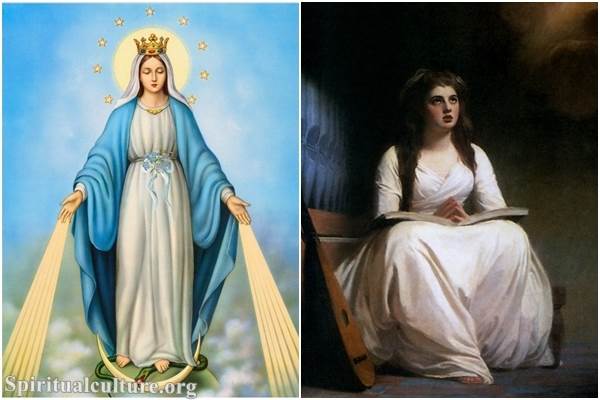There are truths so profound they cannot be fully grasped with the mind alone—they must be received by the heart. The Catholic devotion to Divine Mercy is one such truth. It is not merely a prayer, an image, or a feast day. It is a cry from the very heart of God, echoing across the centuries: “I desire mercy, not sacrifice” (Matthew 9:13).
As Spiritual Culture, we invite you to walk with us through the mystery of Divine Mercy—a devotion born from a Polish nun’s mystical visions, but rooted in the eternal heart of the Gospel. This article will explore where this devotion comes from, what it means, and why it is transforming lives across the world. But more than history or theology, this is a journey into the tenderness of God.
Let us begin where mercy begins—with a wound that longs to be healed.
The Origins of Divine Mercy: A Vision of Heaven’s Compassion
Saint Faustina and the Message from Christ
The modern devotion to Divine Mercy traces its origin to a humble woman: Saint Maria Faustina Kowalska, a Polish nun who lived in the early 20th century. Through her mystical encounters with Christ, recorded in her diary Divine Mercy in My Soul, she was entrusted with a mission: to proclaim to the world God’s unfathomable mercy.
“Proclaim that mercy is the greatest attribute of God.” – Jesus to Saint Faustina, Diary, 301
Jesus appeared to her many times, revealing His heart ablaze with love, and asking that the world come to trust in His mercy. One of the most iconic revelations was the Divine Mercy image: Jesus with rays of red and pale light pouring from His heart, symbolizing blood and water—the streams of grace and mercy flowing from the Cross.
A Devotion Born in Turbulent Times
Faustina’s visions occurred just before the outbreak of World War II, in a Europe on the brink of darkness. It was in this context of rising evil and despair that Christ’s call to mercy rang loudest. It is no coincidence. Divine Mercy was not given for peaceful times—it was entrusted to us precisely when humanity forgets how to love.
The Core Messages of Divine Mercy
“Jesus, I Trust in You”: The Heart of the Devotion
If Divine Mercy had a single breath, it would be this: “Jesus, I trust in You.” These five words form the foundation of the devotion—not as a slogan, but a surrender. They represent a movement from fear to faith, from sin to forgiveness, from despair to hope.
To trust in Divine Mercy is not to ignore suffering. It is to stare it in the face and say: I am not alone.
God’s Mercy Is for All—Especially the Broken
Again and again, Christ tells Faustina that His mercy is for the greatest sinners. The more broken we are, the more right we have to come to Him. In a world where religion is sometimes seen as moral superiority, this message is revolutionary.
“Let the greatest sinners place their trust in My mercy. They have the right before others to trust in the abyss of My mercy.” – Diary, 1146
The Practices of the Divine Mercy Devotion
The Divine Mercy Image
The image of Divine Mercy, painted at Jesus’ request, shows Christ stepping forward in peace, His right hand raised in blessing, His left hand pointing to His heart. The two rays—red for blood, white for water—flowing from His heart are central to the message. Beneath the image are the words: Jesus, I trust in You.
Displaying or venerating this image, especially on Divine Mercy Sunday, is a powerful spiritual act of faith.
The Chaplet of Divine Mercy
One of the central practices is the Divine Mercy Chaplet, a set of prayers that can be said using a rosary. In it, the faithful repeat:
“For the sake of His sorrowful Passion, have mercy on us and on the whole world.”
This simple, repetitive prayer becomes a rhythm of intercession—not only for ourselves but for all souls, especially the dying.
The Hour of Mercy – 3:00 PM
Jesus asked that we honor the hour of His death on the Cross: 3 o’clock in the afternoon. This is called the Hour of Mercy. At this time, we are invited to pause, even briefly, and reflect on His Passion and offer a short prayer.
“At three o’clock, implore My mercy, especially for sinners; and, if only for a brief moment, immerse yourself in My Passion.” – Diary, 1320
Divine Mercy Sunday
On the Sunday after Easter, the Church celebrates Divine Mercy Sunday—a feast instituted by Saint John Paul II in 2000, the same day he canonized Saint Faustina. This day offers unique graces, including a plenary indulgence, for those who receive the Eucharist and go to Confession in a spirit of trust and mercy.
Biblical Roots of Divine Mercy
Though the modern devotion stems from Faustina’s visions, its roots lie deep in Scripture.
God’s Mercy in the Old and New Testaments
From the beginning, God reveals Himself as merciful:
“The Lord is merciful and gracious, slow to anger and abounding in steadfast love.” – Psalm 103:8
The Hebrew word hesed (steadfast love) describes this mercy that never gives up.
In the New Testament, mercy takes on flesh in Jesus:
“Be merciful, even as your Father is merciful.” – Luke 6:36
“Blessed are the merciful, for they shall obtain mercy.” – Matthew 5:7
But nowhere is mercy more visible than in the Crucifixion—where Christ prays for His killers, forgives a thief, and pours Himself out to the last drop.
Why Divine Mercy Matters Today
A World Crying Out for Healing
We live in a time of fragmentation, division, violence, and deep personal wounds. People carry the weight of guilt, shame, fear, and unworthiness. In this, Divine Mercy speaks directly:
You are not beyond love.
You are not too far gone.
Mercy is always greater.
The Catholic devotion to Divine Mercy is not a private comfort—it’s a universal invitation. Jesus doesn’t say, “Fix yourself first.” He says, “Come as you are.”
A Healing for the Church and the World
In a time when the Church herself suffers from scandal, mistrust, and internal wounds, Divine Mercy is balm. It calls clergy and laity alike to return to the heart of the Gospel—not fear, not perfectionism, but mercy.
Trust and Transformation: Real Lives Changed
Countless stories from around the world testify to the power of this devotion. From prisoners to addicts, from grieving mothers to war survivors, many have found healing and purpose through the Chaplet, the image, and the simple act of praying, Jesus, I trust in You.
One prisoner who had lost all hope said he felt “peace for the first time in years” after praying the Chaplet. A woman grieving the loss of her child said the 3 o’clock Hour became her anchor. These are not isolated stories—they are echoes of the same promise.
Reflect and Reimagine
At the heart of the Catholic devotion to Divine Mercy lies this truth: God is not waiting to punish you. He is waiting to love you.
The devotion is not a special club for the pious, but an open door for the wounded. It is a daily reminder that no matter how deep our sins, the ocean of His mercy is deeper still.
As Spiritual Culture, we invite you to pause at 3 o’clock today. Even just for a moment. Whisper from your heart: Jesus, I trust in You.
Then listen. You may just hear Him whisper back:
“I have loved you with an everlasting love.” – Jeremiah 31:3
Interested in praying the Divine Mercy Chaplet? You can learn how here or download a printable guide. Mercy is not far away. It is only one prayer, one breath, one surrender away.
🙏 May mercy find you, wherever you are.



